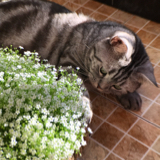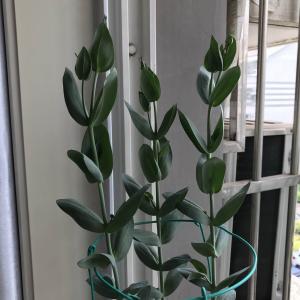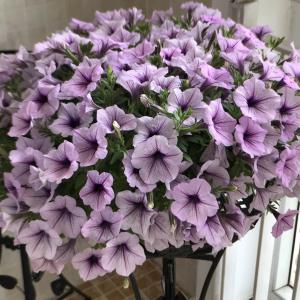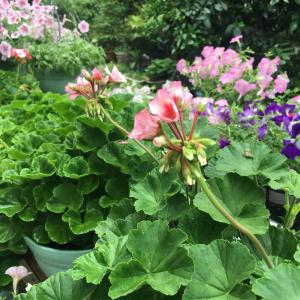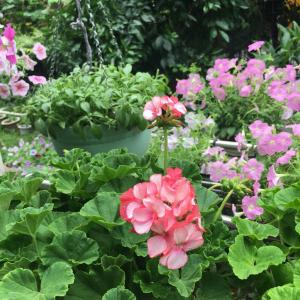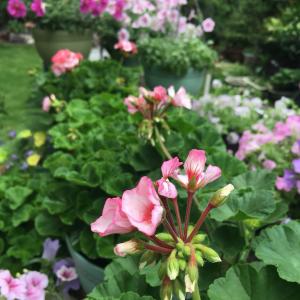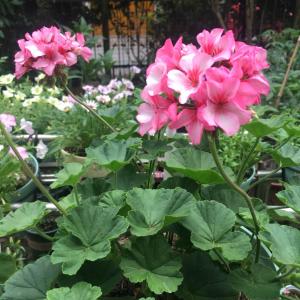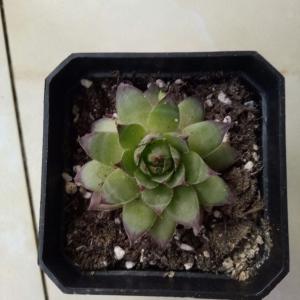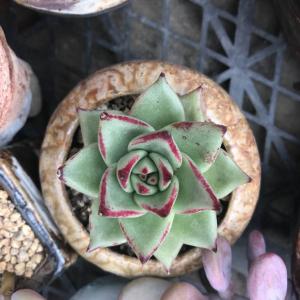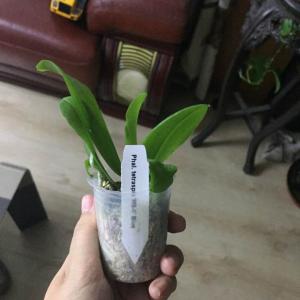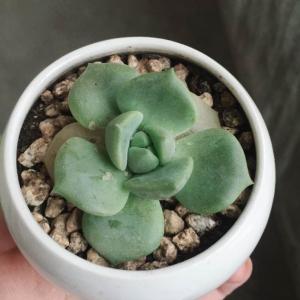文章
Miss Chen
2018年05月25日

Description: This perennial plant is 1-3' tall, branching occasionally in the upper half. The light green to reddish brown stems are usually glabrous; sometimes the central stem has sparse lines of hairs. The alternate leaves are up to 5" long and 3" across (excluding the petioles), becoming smaller as they ascend the stems; they are medium to dark green above and light to medium green below. The lower leaves are cordate, while the upper leaves are cordate-ovate or ovate; their margins are coarsely serrated. Leaf upper surfaces are glabrous, while their lower surfaces are either glabrous or there are hairs along the major veins. The narrow petioles of the leaves are about one-half to almost as long as their blades (up to 3½" in length); they are either unwinged or slightly winged, becoming shorter among the upper leaves. The upper stem terminates in a panicle of flowerheads about ½-1½' long. This panicle is longer than it is wide and it is more broad toward the bottom than the apex. When upper lateral stems are present, much smaller panicles may be produced. The central stalk, lateral branches, and peduncles of each panicle are light to medium green, terete, and glabrous to short-pubescent.
Each small flowerhead is about ½" across, consisting of 7-15 ray florets that surround a similar number of disk florets. The petaloid rays of these flowerheads are lavender, light blue-violet, or less often white; they are linear-oblong in shape. The corollas of the disk florets are short-tubular in shape; these corollas are initially cream-colored or pale yellow, but they later become pale purple to reddish purple with age. The apices of these corollas are 5-lobed; these lobes are short and erect. The base of each flowerhead is surrounded by slender floral bracts (phyllaries) that overlap each other in several series. These scaly bracts are light green, except for diamond-shaped patches of dark green toward their tips; they are linear-lanceolate to narrowly lanceolate in shape and about 3-5 mm. in length. The peduncles of the flowerheads are short (less than ½" in length). Among the branches of each panicle, there are leafy bracts up to 1" long; they are elliptic or linear-oblong in shape. The blooming period occurs from late summer into the fall and lasts about 1-2 months. Afterwards, the florets are replaced by achenes with small tufts of white hair. Individual achenes are 2-3 mm. long and oblongoid-oblanceoloid in shape. The root system is fibrous and short-rhizomatous. This aster reproduces by reseeding itself and vegetatively through its rhizomes.

Cultivation: The preference is light shade or partial sun, moist to dry-mesic conditions, and soil that contains loam, clay-loam, or some rocky material. Occasionally the foliage is affected by powdery mildew and other kinds of disease organisms during the fall. During hot dry weather, the lower leaves may wilt and fall off. Plant size is variable depending on the fertility of the soil and moisture conditions. Plants that are grown in shade will produce smaller panicles of flowers than those that are grown in more sunlight.
Range & Habitat: The native Blue Wood Aster occurs occasionally in scattered counties across Illinois (see Distribution Map). It is more common in the northern half of the state than in the southern half. Habitats include moist to dry deciduous woodlands, woodland borders, areas adjacent to woodland paths, thinly wooded bluffs, shaded areas along streambanks, and rocky wooded slopes. Some disturbance is beneficial in heavily wooded areas if it reduces excessive shade from overhead canopy trees or excessive competition from shrubs.

Faunal Associations: The nectar and pollen of the flowerheads attract many kinds of insects, including long-tongued bees, short-tongued bees, wasps, flies, butterflies, skippers, and beetles. Bees are particularly important pollinators of the flowers. Caterpillars of the butterflies Chlosyne nycteis (Silvery Checkerspot) and Phyciodes tharos (Pearl Crescent) feed on the foliage of asters (Symphyotrichum spp.), as do the caterpillars of many moth species (see Moth Table). Some moth caterpillars also feed on the flowers, developing seeds, stems, and roots. Other insects that feed on these plants include leaf beetles, the larvae of leaf-mining flies and fruit flies, plant bugs, stink bugs, lace bugs, aphids, and leafhoppers (see the Insect Table for a more complete listing of these species). Mammalian herbivores, including rabbits, groundhogs, deer, and livestock, browse on the foliage of asters occasionally. The Wild Turkey and Ruffed Grouse eat both the foliage and seeds to some extent.
Photographic Location: A rocky woodland in west-central Indiana. The inflorescence is small because the photographed plant was growing in a dry upland area of a shady woodland.

Comments: In Illinois, the Blue Wood Aster (Symphyotrichum cordifolium) often hybridizes with Arrow-Leaved Aster (Symphyotrichum sagittifolium) and Drummond's Aster (Symphyotrichum drummondii), which can make the identification of some field specimens from this aster complex very difficult. The Blue Wood Aster can be distinguished from both Arrow-Leaved Aster and Drummond's Aster by its narrow petioles; the petioles of the latter two species are conspicuously winged with narrow green margins. Unlike Drummond's Aster, the Blue Wood Aster has stems and leaf undersides that are hairless or they have lines of hair; the stems and leaf undersides of Drummond's Aster are evenly pubescent. Some authorities consider the preceding species of asters to be varieties of each other, in which case the Blue Wood Aster is the typical variety, Symphyotrichum cordifolium cordifolium. Another woodland species, Short's Aster (Symphyotrichum shortii), is also similar to Blue Wood Aster in appearance, but Short's Aster has larger flowerheads (¾–1" across) and its leaves are smooth to slightly serrated along their margins. Another common name of Symphyotrichum cordifolium is Heart-Leaved Aster. A scientific synonym of this aster is Aster cordifolius.
Each small flowerhead is about ½" across, consisting of 7-15 ray florets that surround a similar number of disk florets. The petaloid rays of these flowerheads are lavender, light blue-violet, or less often white; they are linear-oblong in shape. The corollas of the disk florets are short-tubular in shape; these corollas are initially cream-colored or pale yellow, but they later become pale purple to reddish purple with age. The apices of these corollas are 5-lobed; these lobes are short and erect. The base of each flowerhead is surrounded by slender floral bracts (phyllaries) that overlap each other in several series. These scaly bracts are light green, except for diamond-shaped patches of dark green toward their tips; they are linear-lanceolate to narrowly lanceolate in shape and about 3-5 mm. in length. The peduncles of the flowerheads are short (less than ½" in length). Among the branches of each panicle, there are leafy bracts up to 1" long; they are elliptic or linear-oblong in shape. The blooming period occurs from late summer into the fall and lasts about 1-2 months. Afterwards, the florets are replaced by achenes with small tufts of white hair. Individual achenes are 2-3 mm. long and oblongoid-oblanceoloid in shape. The root system is fibrous and short-rhizomatous. This aster reproduces by reseeding itself and vegetatively through its rhizomes.

Cultivation: The preference is light shade or partial sun, moist to dry-mesic conditions, and soil that contains loam, clay-loam, or some rocky material. Occasionally the foliage is affected by powdery mildew and other kinds of disease organisms during the fall. During hot dry weather, the lower leaves may wilt and fall off. Plant size is variable depending on the fertility of the soil and moisture conditions. Plants that are grown in shade will produce smaller panicles of flowers than those that are grown in more sunlight.
Range & Habitat: The native Blue Wood Aster occurs occasionally in scattered counties across Illinois (see Distribution Map). It is more common in the northern half of the state than in the southern half. Habitats include moist to dry deciduous woodlands, woodland borders, areas adjacent to woodland paths, thinly wooded bluffs, shaded areas along streambanks, and rocky wooded slopes. Some disturbance is beneficial in heavily wooded areas if it reduces excessive shade from overhead canopy trees or excessive competition from shrubs.

Faunal Associations: The nectar and pollen of the flowerheads attract many kinds of insects, including long-tongued bees, short-tongued bees, wasps, flies, butterflies, skippers, and beetles. Bees are particularly important pollinators of the flowers. Caterpillars of the butterflies Chlosyne nycteis (Silvery Checkerspot) and Phyciodes tharos (Pearl Crescent) feed on the foliage of asters (Symphyotrichum spp.), as do the caterpillars of many moth species (see Moth Table). Some moth caterpillars also feed on the flowers, developing seeds, stems, and roots. Other insects that feed on these plants include leaf beetles, the larvae of leaf-mining flies and fruit flies, plant bugs, stink bugs, lace bugs, aphids, and leafhoppers (see the Insect Table for a more complete listing of these species). Mammalian herbivores, including rabbits, groundhogs, deer, and livestock, browse on the foliage of asters occasionally. The Wild Turkey and Ruffed Grouse eat both the foliage and seeds to some extent.
Photographic Location: A rocky woodland in west-central Indiana. The inflorescence is small because the photographed plant was growing in a dry upland area of a shady woodland.

Comments: In Illinois, the Blue Wood Aster (Symphyotrichum cordifolium) often hybridizes with Arrow-Leaved Aster (Symphyotrichum sagittifolium) and Drummond's Aster (Symphyotrichum drummondii), which can make the identification of some field specimens from this aster complex very difficult. The Blue Wood Aster can be distinguished from both Arrow-Leaved Aster and Drummond's Aster by its narrow petioles; the petioles of the latter two species are conspicuously winged with narrow green margins. Unlike Drummond's Aster, the Blue Wood Aster has stems and leaf undersides that are hairless or they have lines of hair; the stems and leaf undersides of Drummond's Aster are evenly pubescent. Some authorities consider the preceding species of asters to be varieties of each other, in which case the Blue Wood Aster is the typical variety, Symphyotrichum cordifolium cordifolium. Another woodland species, Short's Aster (Symphyotrichum shortii), is also similar to Blue Wood Aster in appearance, but Short's Aster has larger flowerheads (¾–1" across) and its leaves are smooth to slightly serrated along their margins. Another common name of Symphyotrichum cordifolium is Heart-Leaved Aster. A scientific synonym of this aster is Aster cordifolius.
0
0
文章
Miss Chen
2018年05月24日

Description: This perennial wildflower is 2-3' tall and usually unbranched. The central stem is light green, terete or angular, and glabrous to hairy; it has a tendency to zigzag between the alternate leaves. The leaf blades are 2-5" long and 1-4" across, becoming shorter and more narrow where the flowers occur; they areFlowering Plant widely spreading. The lower to middle leaves are ovate to broadly ovate, while the upper leaves are more lanceolate. The leaf margins are coarsely serrated. The upper surfaces of the leaves are medium to dark green and glabrous, while their lowers surfaces are more pale and glabrous to slightly hairy. The petioles are ¼–1½" long and somewhat winged near the bases of the leaf blades. At the apex of the central stem, there is a terminal inflorescence about 1½–5" long and about one-third as much across. This inflorescence is either a raceme or narrow panicle of flowerheads. There are also smaller axillary racemes about ½–1½" long that develop from the middle to upper leaves; they are shorter than the leaves. The branches of each inflorescence are light green and glabrous. Each flowerhead is about ¼" across or a little less, consisting of 3-4 yellow ray florets, 4-8 yellow disk florets, and several series of floral bracts at its base. The floral bracts are light green and appressed. The blooming period occurs from late summer to early fall and lasts about 1 month. Both ray and disk florets are fertile. During the fall, the florets are replaced by achenes with small tufts of hair; they are distributed by the wind. The small achenes are bullet-shaped and pubescent. The root system is fibrous and rhizomatous. Vegetative colonies of plants are sometimes formed from the spreading rhizomes.
Cultivation: The preference is light to medium shade, moist to dry-mesic conditions in sheltered situations, and fertile loamy soil with decaying organic matter. This is one of the most shade-tolerant goldenrods.
Range & Habitat: The native Zigzag Goldenrod is occasional in central and northern Illinois, becoming uncommon or absent in the southern section of the state (see Distribution Map). Habitats include rich deciduous woodlands, protected wooded slopes facing north or east, calcareous seeps in wooded areas, low areas along woodland streams, shaded limestone cliffs, and edges of limestone glades. This wildflower is usually found in higher quality natural areas.
Faunal Associations: The flowerheads are pollinated by many kinds of insects, including long-tongued bees, small-tongued bees, wasps, flies, and butterflies. Several bees are oligoleges of Solidago spp. (Goldenrods). These species include: Andrena hirticincta, Andrena nubecula, Andrena placata, Andrena simplex, Andrena solidaginis, and Colletes simulans armata. Many insects feed on the leaves, flowers, seeds, and roots of goldenrods. These insect feeders include plant bugs, stink bugs, aphids, leaf beetles, and the caterpillars of many moths (see the Moth Table and the Insect Table for a listing of these species). These insects are a source of food to many woodland songbirds and some upland gamebirds. White-tailed Deer readily browse on the foliage of Zigzag Goldenrod.

Photographic Location: A wooded slope at Turkey Run State Park in west-central Indiana.
Comments: Zigzag Goldenrod is a member of a small group of woodland goldenrods (Solidago spp.); other species in this group include Solidago caesia (Bluestem Goldenrod) and Solidago ulmifolia (Elm-Leaved Goldenrod). Zigzag Goldenrod often occurs more moist habitats than the latter two goldenrods, but it also occurs in drier areas of woodlands that are sheltered from the prevailing winds and afternoon sunlight. Because of its broad coarsely toothed leaves and axillary racemes of flowerheads, it is one of the easiest goldenrods to identify. Another common name of this species is Broad-Leaved Goldenrod.
Cultivation: The preference is light to medium shade, moist to dry-mesic conditions in sheltered situations, and fertile loamy soil with decaying organic matter. This is one of the most shade-tolerant goldenrods.
Range & Habitat: The native Zigzag Goldenrod is occasional in central and northern Illinois, becoming uncommon or absent in the southern section of the state (see Distribution Map). Habitats include rich deciduous woodlands, protected wooded slopes facing north or east, calcareous seeps in wooded areas, low areas along woodland streams, shaded limestone cliffs, and edges of limestone glades. This wildflower is usually found in higher quality natural areas.
Faunal Associations: The flowerheads are pollinated by many kinds of insects, including long-tongued bees, small-tongued bees, wasps, flies, and butterflies. Several bees are oligoleges of Solidago spp. (Goldenrods). These species include: Andrena hirticincta, Andrena nubecula, Andrena placata, Andrena simplex, Andrena solidaginis, and Colletes simulans armata. Many insects feed on the leaves, flowers, seeds, and roots of goldenrods. These insect feeders include plant bugs, stink bugs, aphids, leaf beetles, and the caterpillars of many moths (see the Moth Table and the Insect Table for a listing of these species). These insects are a source of food to many woodland songbirds and some upland gamebirds. White-tailed Deer readily browse on the foliage of Zigzag Goldenrod.

Photographic Location: A wooded slope at Turkey Run State Park in west-central Indiana.
Comments: Zigzag Goldenrod is a member of a small group of woodland goldenrods (Solidago spp.); other species in this group include Solidago caesia (Bluestem Goldenrod) and Solidago ulmifolia (Elm-Leaved Goldenrod). Zigzag Goldenrod often occurs more moist habitats than the latter two goldenrods, but it also occurs in drier areas of woodlands that are sheltered from the prevailing winds and afternoon sunlight. Because of its broad coarsely toothed leaves and axillary racemes of flowerheads, it is one of the easiest goldenrods to identify. Another common name of this species is Broad-Leaved Goldenrod.
0
0
文章
Miss Chen
2018年05月22日

大丽花之所以被称为世界名花之一,主要是因为它的花期长、花径大、花朵多。在北方地区,花期从5月至11月中旬,在温度适宜条件下可周年开花不断,以秋后开花最盛。精品大丽花最大花径可达到30~40cm,是目前花卉中独一无二的。花色有红、紫、白、黄、橙、墨、复色七大色系,花朵有单瓣和重瓣,单瓣花朵开放时间短些,重瓣花朵开放时间较长。花朵特征与瓣形变化是品种鉴定的主要依据,有球型、菊花型、牡丹型、装饰型、碟型、盘型、绣球型和芍药型等花型的品种群体,以色彩瑰丽,花朵优美而闻名。

在养殖大丽花时,会遇到虫害威胁大丽花的健康,今天我们主要来说一下柳蝙蝠蛾。
形态特征
成虫体长35-44毫米,翅展66-70毫米。体粉褐色至茶褐色。触角短线状。前翅前缘边环状的斑纹,中央有1个深色稍绿色,角形斑纹,斑纹外缘有2条宽的褐色斜带。后翅狭小,腹部长大。卵球形,直径0.6-0.7毫米,黑色,微具光泽。幼虫深褐色、胸、腹部污白色,圆筒形,体具黄褐色瘤突,老熟幼虫体长44-57毫米。
生活史习性
在辽宁大多1年1代,少数2年1代,以卵在地面越冬,或以幼虫在基部越冬。翌春5月中旬开始孵化。6月上旬转向果农林木或杂草等茎中食害。8月上旬开始化蛹г9月下旬化蛹终了。8月下旬羽化为成虫。羽化盛期为9月中旬,终见于10月中旬。成虫羽化后就交尾产卵。以卵越冬。部分后期孵化的幼虫,或受其它干扰发育迟缓的幼虫即以幼虫越冬。翌年在7月旬开始羽化为成虫,随即产卵г2年完成1代。成虫多集中于16-18时羽化。成虫白天多悬挂于树干、下木或杂草上不动,直到日落后才开始飞翔、交尾和产卵。成虫具背光性。交尾后随即产卵,产卵无一定场所,多数随着两翅的颤抖,将卵粒一一产下,有的边交尾边产卵;多数不交尾就产卵。雌虫产卵量几百粒到数千粒不等。

防治方法
1、剪除带有木屑包的苗木和枝条。
2、药剂防治:5月下旬至6月上旬初龄幼虫在地面活动时,向地面喷布50%对硫磷1000倍液。中龄幼虫转入树干时,用50%敌敌畏10倍液滴入虫孔。

在养殖大丽花时,会遇到虫害威胁大丽花的健康,今天我们主要来说一下柳蝙蝠蛾。
形态特征
成虫体长35-44毫米,翅展66-70毫米。体粉褐色至茶褐色。触角短线状。前翅前缘边环状的斑纹,中央有1个深色稍绿色,角形斑纹,斑纹外缘有2条宽的褐色斜带。后翅狭小,腹部长大。卵球形,直径0.6-0.7毫米,黑色,微具光泽。幼虫深褐色、胸、腹部污白色,圆筒形,体具黄褐色瘤突,老熟幼虫体长44-57毫米。
生活史习性
在辽宁大多1年1代,少数2年1代,以卵在地面越冬,或以幼虫在基部越冬。翌春5月中旬开始孵化。6月上旬转向果农林木或杂草等茎中食害。8月上旬开始化蛹г9月下旬化蛹终了。8月下旬羽化为成虫。羽化盛期为9月中旬,终见于10月中旬。成虫羽化后就交尾产卵。以卵越冬。部分后期孵化的幼虫,或受其它干扰发育迟缓的幼虫即以幼虫越冬。翌年在7月旬开始羽化为成虫,随即产卵г2年完成1代。成虫多集中于16-18时羽化。成虫白天多悬挂于树干、下木或杂草上不动,直到日落后才开始飞翔、交尾和产卵。成虫具背光性。交尾后随即产卵,产卵无一定场所,多数随着两翅的颤抖,将卵粒一一产下,有的边交尾边产卵;多数不交尾就产卵。雌虫产卵量几百粒到数千粒不等。

防治方法
1、剪除带有木屑包的苗木和枝条。
2、药剂防治:5月下旬至6月上旬初龄幼虫在地面活动时,向地面喷布50%对硫磷1000倍液。中龄幼虫转入树干时,用50%敌敌畏10倍液滴入虫孔。
0
0
求助
指缝间拾忆
2018年05月21日

我的栀子花叶子黄了4/5,我把黄叶子都修剪掉了,然后花苞以前很多很多,都爆盆了,但是花苞发黄枯萎掉了,昨天我检查根部,很好,没问题,请问花友,这个黄叶掉包是怎么回事?


1
1
Aragorn:你找到原因了吗
Aragorn:我的也是这样,从下开始黄叶,整片的黄,你找到原因了吗
sunnyzou:新入手的吗


